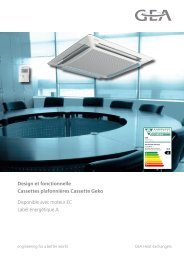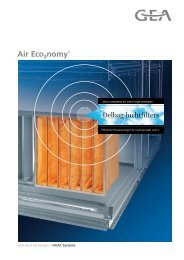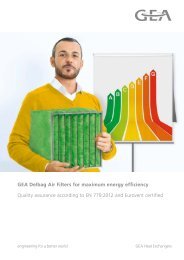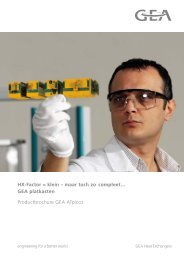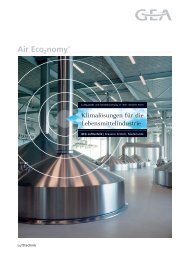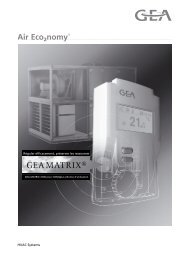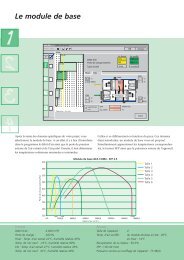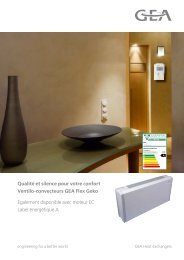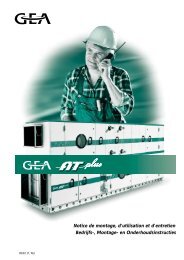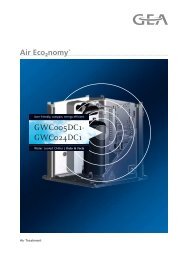GEA Aircooled Condensing Units - GEA Happel Belgium
GEA Aircooled Condensing Units - GEA Happel Belgium
GEA Aircooled Condensing Units - GEA Happel Belgium
You also want an ePaper? Increase the reach of your titles
YUMPU automatically turns print PDFs into web optimized ePapers that Google loves.
Specification<br />
<strong>GEA</strong> <strong>Aircooled</strong> <strong>Condensing</strong> <strong>Units</strong><br />
C-Range<br />
Components are mounted on a rigid galvanised steel base and enclosed by plastic<br />
coated metal side sections and top lid. The base has plastic coated steel channel<br />
feet to assist in transporting and sitting the unit. The feet have holes for securing the<br />
unit in position when installed. The coil and fan(s) are mounted vertically so that air is<br />
drawn through the coil and discharged horizontally through a plastic-coated wire fan<br />
guard. The fan(s) and guard(s) are mounted on a galvanised steel diaphragm. The<br />
compressor and electrical components are mounted in a sealed compartment at the<br />
end of the unit.<br />
Access to this compartment is by a removable panel fitted with a door interlocked<br />
mains isolator. If required, additional access to this area and to the fan(s) can be<br />
provided by removing the lid and side panels, which are held in place by self-tapping<br />
screws.<br />
The refrigerant pipe work between the compressor and condenser is fitted with a<br />
vibration eliminating connector. The compressor suction pipe work is looped to<br />
prevent vibration damage. Condenser liquid and compressor suction pipes terminate<br />
as stub connections protruding through a recessed, galvanised service panel. The<br />
compressor is protected by HP/LP switches, and condenser pressure is controlled by<br />
a fan switch. HP/LP service tapings are on the compressor valves. The <strong>Condensing</strong><br />
<strong>Units</strong> are normally delivered with a 5 psig holding charge of nitrogen.<br />
An electronic fan speed controller is fitted as standard and selects the optimum<br />
condenser fan speed based upon the refrigerant condensing pressure as sensed by<br />
a local transducer. Using this option ensures reliable expansion valve operation<br />
under external winter ambient conditions as low as -30 °C.<br />
The winter start kit is fitted as standard to allow positive refrigeration system start up<br />
under low ambient conditions, this includes a timer to override the low pressure<br />
switch for up to 5 minutes, until sufficient low side operating pressure is reached.<br />
When used in conjunction with the <strong>GEA</strong> Denco C3-05 AH11 controller this function is<br />
provided within the micro processor controls.<br />
The compressor(s) are compliant scroll type running on R407C or R134a, are<br />
complete with isolation valves, crankcase heater, and oil level sight glass. The<br />
compressor is provided with an electrical contactor. For details of compressor sizes<br />
fitted to each <strong>Condensing</strong> Unit, refer to the tables.<br />
Condenser coils are constructed from three rows deep 3 / 8 " o/d copper inner grooved<br />
tubes with aluminium fins spaced at 14 per inch.<br />
The <strong>Condensing</strong> <strong>Units</strong> are normally wired for direct starting from the Air Handling<br />
Unit's controls. A four (4) core 3 phase and neutral cable is required for the power<br />
supply, which is normally supplied from the MCB’s within the Air Handling Unit. For<br />
Standard (single compressor) units, a four (4) core cable is required between the Air<br />
Handling Unit and <strong>Condensing</strong> Unit for control signal and alarms, whilst for V.R.F.<br />
(twin compressor) units a seven (7) core cable is required. The HP/LP switches have<br />
normally open contacts for use when alarm signals are required. These alarms are<br />
connected into the microprocessor controls using the additional cores in the signal<br />
cable.<br />
Signal cables must be segregated from cables carrying mains potential. For long<br />
cable runs provision must be made for voltage drop.<br />
4 PR-2007-0346-GB • Subject to modifications • Status 05/2007



